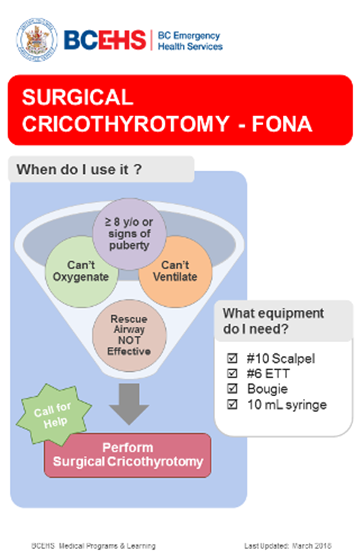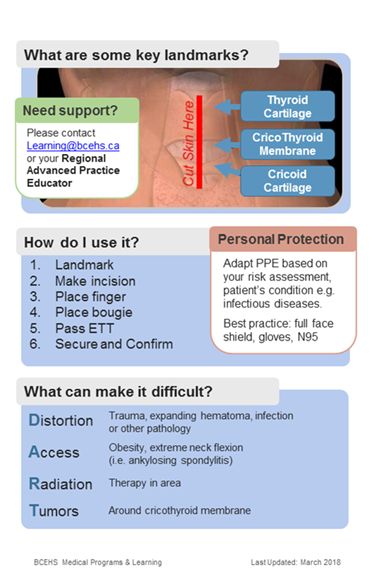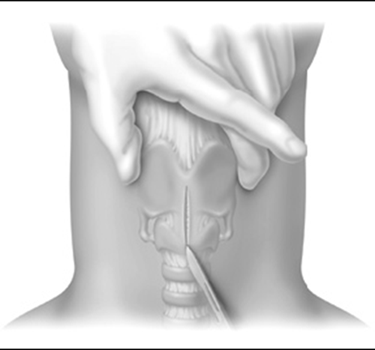Confirmation
PR22: Surgical Airways
Applicable To
Introduction
A surgical airway is indicated in a patient who cannot be oxygenated or ventilated through other means. Paramedics may also consider preparing for surgical airways based on predicted clinical course, or in cases where endotracheal intubation is required and predicted to be difficult.
In patients over the age of 8, the bougie-assisted cricothyromtomy is the preferred approach. In patients under 8, needle cricothyrotomy can be used.
These procedures can be intimidating. Paramedics should have a thorough understanding of the circumstances under which they may be required and have a low threshold for their use. They can also be logistically challenging and frequently require more space (and personnel) than anticipated. In most cases, paramedics will want to approach a surgical airway with their non-dominant hand towards the patient’s head.
Indications
- Inability to ventilate, oxygenate, or intubate a patient
Contraindications
- Absolute: inability to identify landmarks or airway structures
- Relative: trauma to the neck
- Relative: history of perithyroid tumors or radiation to the neck
- Relative: expanding hematomas or other pathologies distorting structures in the neck
Procedure
Procedure: Bougie-Assisted Cricothyrotomy
- Personal protective equipment is required for this procedure. Face shields are critically important: upon puncturing the cricothyroid membrane, a spray of blood is frequently produced.
- Assemble required equipment: scalpel blade, bougie, and 6.0 ETT.
- Identify the landmarks as required.
- Stabilize the thyroid cartilage with the non-dominant hand. The dominant hand will hold the scalpel and rest on the patient’s sternum for stability.
- Make a 4 cm vertical incision through the skin over the cricothyroid membrane. In cases where the anatomy cannot be palpated or identified prior to making the incision, it may be necessary to extend the incision from the mandible to the sternum.
- Palpate the cricothyroid membrane and bluntly dissect through the subcutaneous tissue using a finger until the membrane is readily identifiable. Puncture the membrane with the scalpel held horizontally.
- Remove the scalpel and place a little finger in the incision in the membrane to dilate and to identify the posterior wall cartilage. Ignore any bleeding at this point.
- Slide the bougie alongside the little finger into the trachea.
- Remove the finger and pass the endotracheal tube over the bougie and into the trachea. Only advance the endotracheal tube until the balloon is within the airway and no longer visible. Inflate the balloon.
- Holding the endotracheal tube firmly, remove the bougie and connect a bag-valve mask. Confirm endotracheal tube placement with end-tidal CO2 monitoring, auscultation, bilateral chest rise and fall, and misting of the tube.
Procedure: Needle Cricothyrotomy
Children under the age of 8 should not have open cricothyrotomies as there is an unacceptable risk of causing damage to poorly-developed structures in the airway. Needle cricothyrotomy is an option in these cases. Paramedics must remember this procedure is a bridge to definitive airway management: it is possible, using this technique, to oxygenate (but not ventilate) a patient for a brief period of time, typically 15 to 20 minutes.
- Assemble required equipment:
- 14-gauge Angiocath; remove flash cap
- 10 mL syringe
- Number 3 endotracheal tube; remove the universal connector from the endotracheal tube
- Identify landmarks: the cricothyroid membrane in children is located in the same position as adults and should be palpable through the skin below the thyroid cartilage.
- Attach 10 mL syringe to 14-gauge Angiocath. Hold the syringe in the dominant hand, which is stabilized on the patient’s mandible.
- Puncture the skin over the cricothyroid membrane. Once through the skin, direct the needle tip caudally. At the same time, gradually retract the plunger on the 10 mL syringe until the plunger retracts freely, signaling entry into the trachea. Remove the plunger.
- Advance the needle slightly, then withdraw the needle while threading the catheter into the trachea.
- Insert the size 3 endotracheal tube connector in the catheter.
- Secure the catheter and endotracheal tube connector with an occlusive dressing (e.g., Tegaderm). Form a hole in the occlusive dressing for the endotracheal tube connector.
- Connect a bag-valve mask attached to high-flow oxygen.
- Ventilate, being aware that higher pressures may be required and that chest rise may not be seen. The pressure relief valve will likely need to be locked down.
Notes



Resources